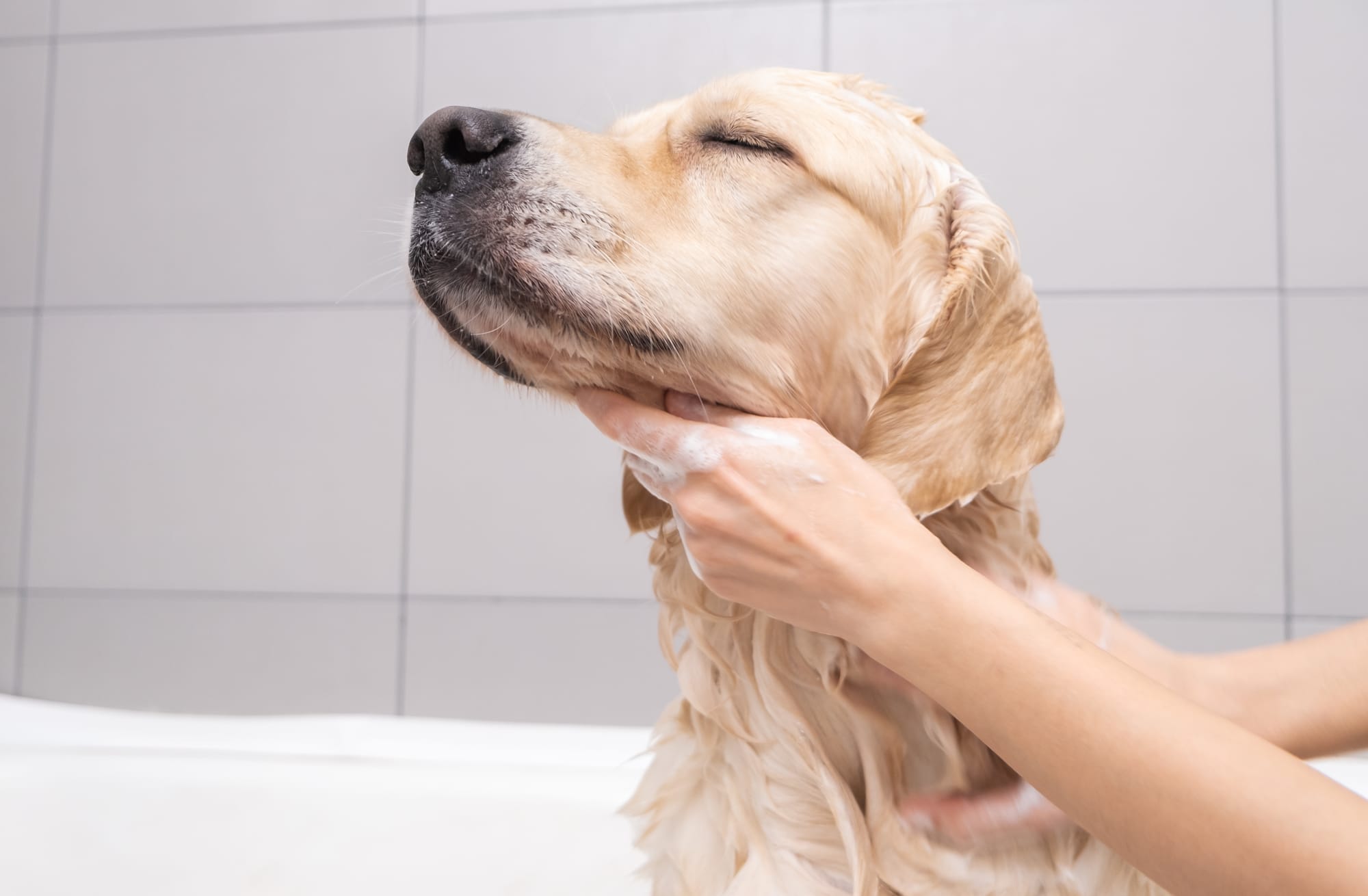Bathing your dog is an essential part of their hygiene routine. It helps to keep their coats clean and healthy, and it can also prevent skin irritations and infections. However, many dog owners are unsure how often they should bathe their furry friend. One question that often arises is whether it's safe to bathe a dog every day.

While it may seem like a good idea to bathe your dog every day, it's generally not necessary or recommended. Dogs have natural oils in their skin and coat that help to keep them healthy and comfortable. Over-bathing can strip these oils away, leaving your dog's skin dry and itchy. It can also lead to other skin problems, such as hot spots and rashes.
So, how often should you bathe your dog? The answer depends on a few factors, including their breed, activity level, and skin type. In general, most dogs only need to be bathed every 2-3 months. However, some breeds with oily skin, such as Basset Hounds and Cocker Spaniels, may need more frequent baths. Dogs that spend a lot of time outdoors or have skin allergies may also need more frequent bathing to keep their skin clean and healthy.

Understanding Your Dog's Skin and Coat
When it comes to bathing your dog, it's important to understand their skin and coat. Dogs have a different skin pH level than humans, which means that they require different care. Here are some key factors to keep in mind:
The Role of Natural Oils
Dogs have natural oils on their skin and coat that help to protect and moisturize them. Regular bathing can strip these oils away, leading to dry skin and irritation. This is why it's generally recommended that dogs be bathed no more than once a month, unless they have a specific skin condition that requires more frequent bathing.
Recognizing Skin Conditions
If your dog has a skin condition, such as allergies or dermatitis, they may require more frequent bathing or special shampoos. It's important to work with your veterinarian to develop a treatment plan that meets your dog's specific needs.
In addition to skin conditions, you should also keep an eye out for signs of dry or irritated skin. These can include itching, redness, and flaking. If you notice any of these symptoms, it may be time to adjust your dog's bathing routine or seek veterinary care.
Overall, it's important to be mindful of your dog's skin and coat when deciding how often to bathe them. By understanding their unique needs, you can help keep them healthy and comfortable.
Factors Influencing Bathing Frequency
When it comes to deciding how often to bathe your dog, there are several factors to consider. Here are some of the key factors that can influence how frequently your furry friend needs a bath.
Breed and Hair Type
The breed and hair type of your dog can play a significant role in determining how often they need to be bathed. Long-haired breeds, for example, may require more frequent bathing to keep their coats clean and free of tangles. Short-coated or hairless breeds, on the other hand, may not need to be bathed as often.
Activity Level and Lifestyle
The activity level and lifestyle of your dog can also impact how often they need a bath. Dogs that spend a lot of time outdoors or engage in activities that get them dirty or sweaty may need to be bathed more frequently than those that lead a more sedentary lifestyle.
Age and Health Considerations
Another important factor to consider is your dog's age and health. Puppies may need to be bathed more often than adult dogs, as they tend to get into more messes and may not have fully developed their grooming habits yet. Dogs with certain health conditions may also require more frequent bathing to help manage their symptoms.
Overall, there is no one-size-fits-all answer to the question of how often to bathe your dog. By taking into account factors like breed, activity level, and health considerations, you can determine a bathing schedule that works best for your furry friend.

Choosing the Right Shampoo
When it comes to bathing your dog, choosing the right shampoo is crucial to maintaining their skin and coat health. There are a variety of dog shampoos available in the market, but not all are created equal. In this section, we will discuss the different types of shampoos available for dogs and how to choose the right one for your furry friend.
Shampoo for Different Skin Types
Just like humans, dogs have different skin types that require different types of shampoos. If your dog has normal skin, a regular dog shampoo will suffice. However, if your dog has sensitive skin or suffers from skin allergies, you should look for a shampoo that is specifically formulated for sensitive skin. These shampoos are usually free of harsh chemicals and fragrances that can irritate the skin.
On the other hand, if your dog has oily skin, you should look for a shampoo that is designed to control oil production. These shampoos typically contain ingredients like salicylic acid that can help reduce excess oil and prevent skin infections.
If your dog has dry skin, you should look for a moisturizing shampoo that contains ingredients like oatmeal or aloe vera. These ingredients can help soothe dry, itchy skin and restore moisture to the coat.
Medicated Shampoos for Specific Conditions
If your dog suffers from a specific skin condition, your veterinarian may recommend a medicated shampoo to help manage their symptoms. Medicated shampoos are formulated with specific active ingredients that can help treat conditions like fungal or bacterial infections, seborrhea, or hot spots.
When using a medicated shampoo, it is important to follow your veterinarian's instructions carefully. Some medicated shampoos may need to be left on the coat for a certain amount of time before rinsing off, while others may need to be used in conjunction with other medications.
In conclusion, choosing the right shampoo for your dog is essential to maintaining their skin and coat health. By understanding your dog's skin type and any specific conditions they may have, you can choose a shampoo that will help keep them clean and comfortable.
The Bathing Process

Preparing for Bath Time
Before starting the bathing process, it is important to gather all the necessary supplies. This includes dog shampoo, towels, a brush, and a non-slip mat. It is also important to ensure that the water temperature is warm, but not hot, as dogs have sensitive skin.
It is recommended to brush your dog's coat before bathing to remove any tangles or mats. This will also help to distribute natural oils throughout the coat, which can improve its overall health.
Additionally, it is important to protect your dog's eyes, ears, and teeth during the bathing process. This can be done by using a gentle, tear-free shampoo for the eyes and face, and by placing cotton balls in the ears to prevent water from entering. It is also recommended to brush your dog's teeth regularly to maintain good oral hygiene.
Step-by-Step Bathing Guide
- Wet your dog's coat thoroughly with warm water, avoiding the head and ears.
- Apply a small amount of dog shampoo to the coat and lather well, starting at the neck and working your way down to the tail.
- Use a gentle, circular motion to massage the shampoo into the coat, being careful not to get any in your dog's eyes or ears.
- Rinse the coat thoroughly with warm water, ensuring that all shampoo is removed.
- Use a towel to gently pat your dog dry, starting with the head and working your way down to the tail.
- Brush your dog's coat to remove any remaining tangles or mats.
It is important to note that dogs should not be bathed too frequently, as this can strip their coat of natural oils and lead to skin irritation. The frequency of bathing will depend on your dog's breed, activity level, and lifestyle. It is recommended to consult with your veterinarian to determine the appropriate bathing frequency for your dog.
Post-Bath Care
After giving your dog a bath, it is important to properly care for their coat and overall hygiene. This section will cover some essential post-bath care steps to ensure your dog stays healthy and happy.
Drying and Grooming
Once your dog is out of the bath, gently towel dry them to remove excess water. It is important to avoid using a hairdryer as the heat can damage their skin. Instead, use a deshedding tool or brush to remove any loose fur. Regular grooming, such as brushing, can also help prevent matting and keep their coat healthy and shiny.
Ear Cleaning and Nail Trimming
After a bath is a good time to clean your dog's ears and trim their nails. Use a cotton ball or pad to clean the outer ear, being careful not to insert anything into the ear canal. If your dog has long hair around their ears, consider using scissors or clippers to trim it back to prevent matting and infection. For nail trimming, use a sharp clipper and be careful not to cut the quick, which can cause bleeding and pain.
Overall, post-bath care is an important part of keeping your dog healthy and comfortable. Regular grooming, ear cleaning, and nail trimming can help prevent infections and other health issues. With proper care, your dog can enjoy the benefits of a clean and healthy coat.
Common Concerns and Tips

Dealing with Fears and Anxiety
Some dogs may become nervous or anxious when it comes to bath time. It is important to make the experience as comfortable and stress-free as possible. One way to do this is by using peanut butter or other treats to distract and reward the dog during the bath.
Another tip is to make sure the water temperature is warm but not too hot, as this can cause discomfort and further anxiety. It is also important to use a non-slip mat in the bathtub to prevent the dog from slipping and getting hurt.
Managing Odor and Greasiness
Bathing a dog every day can help manage odor and greasiness, but it is important to use the right shampoo and conditioner. Look for products that are specifically designed for dogs and avoid using human products, as they can be too harsh for a dog's sensitive skin.
It is also important to rinse the dog thoroughly to remove all traces of shampoo and conditioner, as leftover residue can cause skin irritation and dryness. After the bath, make sure to dry the dog thoroughly to prevent any lingering dampness and potential skin problems.
Overall, bathing a dog every day can be beneficial for managing odor and greasiness, but it is important to take into consideration the dog's individual needs and preferences. With the right products and techniques, bath time can be a comfortable and enjoyable experience for both the dog and the owner.
Professional Grooming vs. Home Baths
When it comes to keeping your furry friend clean and healthy, pet parents often wonder whether they should take their dog to a professional groomer or bathe them at home. Both options have their advantages and disadvantages, and it ultimately depends on your dog's specific needs and your personal preferences.
When to Consult a Professional Groomer
If your dog has a thick coat or requires a specific haircut, it may be best to consult a professional groomer. Groomers have the necessary tools and expertise to groom your dog safely and efficiently. They can also provide additional services such as nail trimming, ear cleaning, and teeth brushing.
Additionally, if your dog has skin issues or allergies, a professional groomer may be able to recommend specific shampoos or treatments to help alleviate their symptoms. It's always a good idea to consult with a veterinarian before scheduling a grooming appointment, especially if your dog has any underlying health conditions.
Benefits of Regular Professional Grooming
Regular grooming by a professional can help keep your dog's coat healthy and shiny, prevent matting and tangling, and promote good hygiene. Groomers can also help identify any potential health issues such as lumps, bumps, or skin irritations.
Moreover, regular grooming can help reduce shedding and minimize the amount of hair your dog leaves around the house. It can also help reduce the risk of infections and infestations, such as fleas and ticks.
Overall, while home baths can be convenient and cost-effective, professional grooming offers a range of benefits that can help keep your dog healthy and happy. Whether you choose to groom your dog at home or take them to a professional, make sure to prioritize their hygiene and well-being.

Preventing Bath-Related Issues
Regular bathing is essential for your dog's health and hygiene, but over-bathing can lead to several issues. Here are some tips to prevent bath-related problems:
Avoiding Over-Bathing
Excessive bathing can strip your dog's skin of natural oils, leading to dry and itchy skin. It can also cause dander and make your dog more prone to parasites such as fleas and ticks. To avoid over-bathing, follow these guidelines:
- Bathe your dog no more than once a week, unless recommended by a veterinarian.
- Use a mild shampoo specifically formulated for dogs.
- Rinse your dog thoroughly to ensure no shampoo residue is left behind.
- Dry your dog completely after the bath to prevent skin irritation.
Protecting Against Parasites
Parasites such as fleas and ticks can latch onto your dog's skin and cause discomfort and health issues. Here are some ways to protect your dog against parasites:
- Use a flea and tick preventative medication recommended by your veterinarian.
- Check your dog for fleas and ticks regularly, especially after spending time outdoors.
- Use a flea comb to remove any fleas or ticks found on your dog.
- Wash your dog's bedding regularly to prevent infestations.
By following these tips, you can keep your dog clean and healthy without causing any bath-related issues.
Conclusion
While keeping your dog clean is important for their health and comfort, bathing them every day is unnecessary and can potentially harm their skin and coat. By understanding your dog's specific needs and following proper bathing techniques, you can ensure they stay clean and healthy without overdoing it.

Frequently Asked Questions (FAQs)
- How often should I bathe my short-haired dog?
- The frequency of bathing a dog depends on several factors, including the breed, activity level, and skin condition. Short-haired dogs with healthy skin can typically go for a bath every 2-3 months. However, if your dog has skin allergies or is prone to skin infections, you may need to bathe them more frequently. It is best to consult with your veterinarian to determine the appropriate bathing frequency for your dog.
- What are the signs that my dog needs a bath?
- Some common signs that your dog needs a bath include a strong odor, greasy or dirty coat, excessive scratching, and visible dirt or debris on their skin. However, it is important to note that over-bathing can strip your dog's skin of its natural oils, leading to dryness and irritation. Therefore, it is essential to find the right balance and avoid over-bathing your dog.
- Is it safe to bathe my dog multiple times a week?
- Bathing your dog multiple times a week is generally not recommended, as it can lead to dryness and irritation of the skin. However, if your dog has a skin condition that requires frequent bathing, your veterinarian may recommend a medicated shampoo and a specific bathing schedule to manage the condition.
- How frequently can I bathe my dog if he has fleas?
- If your dog has fleas, you may need to bathe them more frequently to help control the infestation. However, it is important to use a flea shampoo specifically designed for dogs and follow the instructions carefully. Over-bathing with a flea shampoo can be harmful to your dog's skin and coat.
- What is considered too frequent for dog baths?
- Bathing your dog too frequently can lead to dryness and irritation of the skin. The ideal frequency of bathing depends on your dog's breed, activity level, and skin condition. Generally, bathing your dog every 2-3 months is sufficient for most healthy dogs. However, if your dog has a skin condition, you may need to bathe them more frequently.
- Is it okay for my dog to get wet every day?
- It is generally okay for dogs to get wet every day, as long as they are not being bathed with shampoo every day. Swimming, playing in the rain, or getting wet during a walk are all okay for most dogs. However, it is important to dry your dog thoroughly after they get wet to prevent skin irritation and infections.




